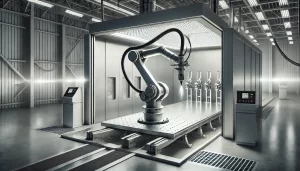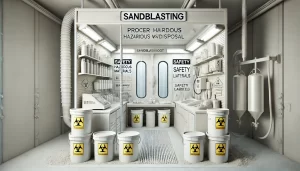Sandblasting, also known as abrasive blasting, is a versatile and highly effective technique used in various industries to clean, smooth, or shape surfaces. It is a process that has revolutionized surface preparation, making tasks like removing paint, rust, or other contaminants far more efficient. Whether you’re working with metal, wood, concrete, or glass, sandblasting offers a powerful solution to achieve a clean and even finish. But what exactly is sandblasting, and how does it work? Let’s dive into the details in simple terms.
Understanding Sandblasting
At its core, sandblasting is a process that propels fine particles at high speeds onto a surface. The particles, commonly referred to as the “abrasive,” strip away unwanted material or prepare the surface for further treatment, such as painting, coating, or welding. Imagine it as a supercharged form of scrubbing—only instead of using a sponge or brush, you’re using tiny abrasive materials propelled by compressed air or water.
The term “sandblasting” originally comes from the use of sand as the primary abrasive material. However, as technology has advanced, so has the range of materials used. Today, sand is just one of many options, with alternatives like aluminum oxide, glass beads, steel grit, and even organic materials such as walnut shells or corn cobs being used for specific applications.
How Does Sandblasting Work?
The process of sandblasting is relatively straightforward in concept but requires precision and the right equipment to execute effectively. Here’s a step-by-step explanation of how it works:
Preparation of the Surface
Before starting, the surface that needs sandblasting must be prepared. This may involve masking off areas that should not be blasted, ensuring safety measures are in place, and selecting the appropriate abrasive material for the job.
Choosing the Abrasive Material
Different surfaces and tasks require different abrasives. For instance, tough materials like steel might need a coarser abrasive like steel grit, while delicate surfaces like glass would use softer materials like fine glass beads. The choice of abrasive directly impacts the final finish and ensures the surface isn’t damaged during the process.
Setting Up the Equipment
Sandblasting requires a few essential tools:
- Blast Pot: This is the container that holds the abrasive material.
- Compressor: The compressor provides the high-pressure air or water needed to propel the abrasive.
- Nozzle: The nozzle directs the abrasive material onto the surface with precision.
- Once the equipment is set up and the abrasive is loaded into the blast pot, the system is pressurized and ready to go.
The Blasting Process
The actual blasting begins when the nozzle is aimed at the surface, and the abrasive material is released under high pressure. The force of the particles hitting the surface removes rust, paint, dirt, or any other unwanted material. Depending on the goal, the operator adjusts the pressure and the distance of the nozzle to achieve the desired effect.
Cleaning and Finishing
After the blasting is complete, the surface is cleaned to remove any residual abrasive material. This step ensures the surface is ready for the next phase, whether that’s painting, coating, or sealing.
Applications of Sandblasting
One of the reasons sandblasting is so popular is its versatility. It can be used in a wide range of industries and for various purposes:
- Surface Preparation: Sandblasting is a go-to method for preparing surfaces before painting or coating. It ensures that the surface is clean and roughened up enough for the coating to adhere properly.
- Rust and Paint Removal: Removing old paint, rust, or corrosion from metal surfaces is one of the most common uses of sandblasting. It’s especially helpful in automotive, marine, and construction industries.
- Restoration Work: Sandblasting is often used to restore old or worn-out items, such as antiques, furniture, or machinery. It removes years of grime or coatings without damaging the underlying material.
- Etching and Engraving: In decorative applications, sandblasting can be used to etch intricate designs onto glass, stone, or metal, creating stunning visual effects.
- Cleaning: Industrial equipment, buildings, and even historical monuments can benefit from sandblasting to remove dirt, grease, or other contaminants.
Why Sandblasting Stands Out
The popularity of sandblasting stems from several key advantages. First and foremost, it’s incredibly efficient. Compared to manual methods like sanding or scraping, sandblasting gets the job done in a fraction of the time. It’s also more thorough, capable of reaching into nooks and crannies that other methods might miss.
Another major benefit is its adaptability. With the right equipment and abrasive, sandblasting can handle everything from delicate glass etching to heavy-duty industrial cleaning. This makes it a valuable tool for professionals across many industries.
Finally, sandblasting is eco-friendly when done responsibly. Modern setups can recycle abrasive materials, reducing waste. Additionally, many abrasives, such as walnut shells or glass beads, are biodegradable or inert, minimizing environmental impact.
Safety in Sandblasting
While sandblasting is a highly effective technique, it’s not without its risks. The process generates a significant amount of dust and debris, which can pose health and safety hazards if not properly managed. Operators must wear protective gear, including respirators, goggles, gloves, and full-body suits, to shield themselves from harmful particles.
Proper ventilation and dust collection systems are critical in industrial settings to ensure the safety of workers and the environment. Following industry regulations and best practices is essential to minimizing risks and achieving the best results.
The Role of Sandblasting in Paint Booths
For businesses involved in painting and coating, sandblasting plays a crucial role in ensuring high-quality finishes. A clean, well-prepared surface is the foundation of any durable paint job. Without proper surface preparation, paint can chip, peel, or fail to adhere correctly.
By integrating sandblasting into your workflow, you can achieve superior adhesion, extend the lifespan of your coatings, and enhance the overall appearance of your products. Many paint booth setups are designed to be compatible with sandblasting equipment, making it easier to streamline your operations.
Specialized Sandblasting Booth Services
We specialize in providing top-quality sandblasting booths and custom finishing solutions tailored to meet the unique needs of various industries. Our expert team designs and manufactures state-of-the-art sandblasting booths that ensure safety, efficiency, and superior performance. From automotive and aerospace to marine and industrial applications, our booths are engineered to handle even the most demanding surface preparation tasks. We offer comprehensive services, including booth installation, maintenance, upgrades, and technical support.




